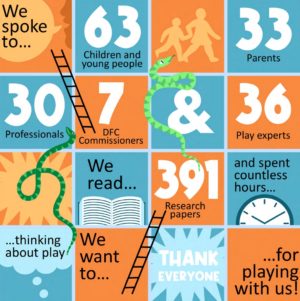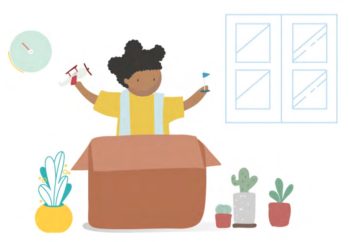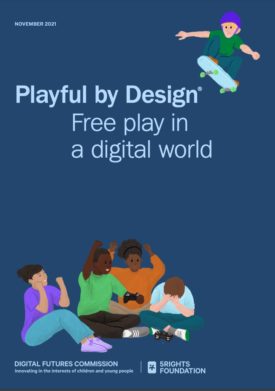What better subject to zoom in on during the holiday season than play? I’ve written a lot on the subject, here, through the years but, in a way, this is Part 4 of a series I started in 2009 (here are the 2nd and 3rd parts). So now, at the turn of a new year, it’s not only a perfect time but high time to come back to the power of play. Happy holidays to all who celebrate them, happiness to those who celebrate other ones and thank you all for all you do for kids and families wherever you are!

“We have become a culture that is overtly pre-packaged and prescribed,” award-winning middle school teacher Marianne Malmstrom told me back in 2012. “Kids are starved for a place to simply play. They want their bricks! They want their friends! And they want a space to play and exercise their own creativity with their friends!”
By “bricks,” she meant the digital objects that kids can create from scratch – then play in and with – in free-play spaces like Minecraft (Marianne had set up a custom Minecraft server for her school long before other teachers had and years before Microsoft acquired Minecraft’s Swedish parent, Mojang). It was as if she was predicting an important report just released by the Digital Futures Commission in the UK. “Playful by Design” calls out the importance of giving children spaces for free play in a digital sense and helps parents and tech companies understand what that looks like.
There is serious guidance for smart digital play design, here. Not only did the authors, Drs. Sonia Livingstone and Kruakae Pothong, seek input from children (63, aged 3-18) and parents (33), but also 30 professionals who work with children and 36 experts on play, representing ethnic and cultural diversity. They also conducted two research lit reviews (of 201 studies of free play in digital environments and 190 of free play in general). Their aim? To get at what children love about free play and make evidence-based recommendations on how to maximize children’s opportunities for free play and avoid the elements that children themselves say keep it from happening.
So exactly what is free play?
Put a plain-old cardboard box in a room with a kid for a good while and go away. Free play will just happen, and there’ll be about as many versions of it as individuals who get to play with the box. The same thing goes with a bag of LEGO bricks or the infinite number of “bricks” in Minecraft or the infinite ways to design a game in Roblox. Or take what a husky did when approached by a hungry polar bear in the Arctic Circle (I’ll come back to that in the part about safety). That’s just the individual version; the variety can get exponential when whole groups of kids play with a box, of course.
What I gathered is that free play happens sort of inside out – from the child, in the moment. It’s kid-driven and not about outside control, whether it might be a digital game system or adults calling the shots.
There can be rules, of course – it’s just that they’re more like the artistic constraints that spur creativity (see No. 6 under “What does work” in this post) – but don’t look for a purpose. “If its purpose is more important than the act of doing it, it’s probably not play,” said Stuart Brown, a psychiatrist and founder of the National Institute for Play.
 Play is necessary
Play is necessary
Free play is intrinsically motivated, voluntary, open-ended, stimulating, immersive, social, diverse (takes all sorts of forms), imaginative, safe and involves risk-taking (because “one needs a degree of safety to be able to take risks”), emotionally resonant and enables a sense of achievement, the authors of “Playful by Design” tell us. It’s therapeutic. It’s necessary to child development. It’s also a right enshrined in the 32-year-old UN Convention on the Rights of the Child (see Art. 31).
That first one I mentioned is important: references to “intrinsically motivated” appear 60 times in the report. This reminds me of something. Back in 2012, when “gamification” was the hot topic in popular business culture, Prof. Scott Nicholson gave a talk at the Games, Learning & Society conference on “meaningful gamification” and the difference between “intrinsic rewards” and extrinsic ones. The latter – points, prizes, treats – are extrinsic, rewards outside of you that create a kind of addiction, dependency or external control. You have to keep coming back to get more. Whereas intrinsic rewards – agency or autonomy, relatedness or relevance and a sense of competency – have the opposite effect. They’re rewards in and of themselves, they’re part of you, so you’re in the driver’s seat.
The autonomy part indicates that safety requires a balance between external protective features and player autonomy. Striking that balance can be particularly hard for companies providing play spaces at a time when policymakers and societies around the world are calling for more safety controls on tech companies’ part.
Play-appropriate business model
All this asks a whole lot of the people who design spaces for free play. But what a gift to them too: to have the goal and all the elements spelled out, all resting on a solid evidence base. On p. 33 of the report, the authors have lists of “likely enablers” of free play (e.g., easy onboarding, communication tools, users’ ability to control their privacy and inter-generational) and likely inhibitors of it. I would suggest users need a degree of control where their safety’s concerned too. There is such a thing as too safe – so safe that play and creativity are constrained through safety restrictions and pre-determined outcomes, a teacher and her students found (see this).
For parents looking for reliable perspectives on specific digital games and services, starting on p. 40, the authors offer 8 case studies of Fortnite, Minecraft, Nintendo Wii and RingFit Adventure, Roblox, TikTok, WhatsApp, YouTube and Zoom – from both children’s and experts’ viewpoints.
Then there’s the business model. The other support digital designers need is a child-appropriate business model – or rather a play–appropriate one. We might look for another study focused just on this. Many platforms have special community rules, features and enforcement (content moderation) for minors, but they also need to consider the business model. For example, 1) if a product is ad-supported, can the service ensure that all ads are child-appropriate; 2) if not, can ad revenue from other parts of the business support the children’s part?
Free play is protective
The amazing thing is play is also protective – disarming in a threatening moment and growing resilience and healthy minds over time, according to a psychiatrist, a philosopher and a psychologist.
Free play can disarm, ease tension and create a sense of shared purpose, camaraderie and belonging. That’s what happened with the polar bear and the husky I mentioned above – psychiatrist Stuart Brown’s story of how one of the huskies, who was chained up and could not run away, started to play with the hungry polar bear. In what started out as a life-and-death situation, after the dog went into play mode, the bear not only joined in the play but also came back to play the next day and the next and the next, Brown said in an interview in 2009 (link no longer available, but again with radio host Krista Tippett in 2014).
But he wasn’t just talking about non-human animals. The story was an illustration of insight he gained about healthy development from studying people who hadn’t experienced it: convicted killers. In the study, he found that the one thing the people he interviewed had in common was “severe play deprivation” or “progressive suppression of developmentally normal play,” as he put it in a 2008 talk.
“Pointless play” needed
So play – particularly “pointless play,” as British philosopher Nigel Warburton recently wrote – is protective in various ways. Besides the spontaneous kind of creativity the husky exhibited, free play grows resilience. “When we play just for the sake of it, we develop, in the longer term, our potential to deal  with unexpected new situations….” He cites psychology professor Alison Gopnik at University of California, Berkeley, saying, “The fundamental paradox of play is that, in order to be able to reach a variety of new goals in the long run, you have to actively turn away from goal-seeking in the short run.” In other words, don’t burden play with purpose and instead reap all sorts of benefits!
with unexpected new situations….” He cites psychology professor Alison Gopnik at University of California, Berkeley, saying, “The fundamental paradox of play is that, in order to be able to reach a variety of new goals in the long run, you have to actively turn away from goal-seeking in the short run.” In other words, don’t burden play with purpose and instead reap all sorts of benefits!
Which leaves us with some really important questions here at a time of increasing calls for more regulation and parental control, as I watch lawmakers pressure tech companies in this direction (someone please tell them how important pointless play is!):
- How can we stop making safety in digital spaces so much about control and surveillance and at least as much about respecting and allowing children’s agency, competency and own interest in safety for the purpose of optimizing fun?
- How can we encourage companies to find and strike a balance between internal (player-sourced) and external (company-provided) safeguards in play spaces?
- How can we encourage US companies to honor the UN Convention on the Rights of the Child – which defines “play” as “any behaviour, activity or process initiated, controlled and structured by children themselves” – even though the US is the only country on the planet that hasn’t ratified the convention?
How can we make sure kids have room for joy, spontaneity and even a little trial and error in digital spaces?
Related links
- “What is meant by ‘by design’?” – a follow-on essay by the authors of “Playful by Design”
- “Play” – a video talk by Dr. Shuli Gilutz at Tel Aviv University on ethical child-centered design for digital environments
- D4CR Association: Designing for Children’s Rights
- How students of teacher Marianne Malmstrom became “MiniDevs,” or mini developers in a collaboration with New Zealand tech consultancy Theta
- “Children know something that adults have forgotten,” writes dad and University of Miami philosophy professor Mark Rowlands. I’ll let you read his essay to find out what. ;)
- “Play Needs No Purpose,” by Parker Palmer, teacher, author and founder of the Center for Courage & Renewal
- How UNICEF describes free play
- “‘Let children play’: the educational message from across Europe,” by Guardian correspondents in France, Germany, Italy and Spain (April 2021)
- “If you want children to learn more, let them play more,” write Finn Pasi Sahlberg and American William Doyle, authors of Let the Children Play: How More Play Will Save Our Schools and Help Children Thrive. If you need more excuses to let them play, these authors provide them.
- Kid Club for kids 8-13 – virtual camp for connected play (and learning)
- A stark example of the difference between free play and the more adult-organized kind – and how learning happens with the former – from teacher Marianne Malmstrom, 2011 winner of the Teacher of the Future award from the US National Association of Independent Schools (here’s her bio)
- Also in NetFamilyNews.org, “The benefits of agency, choice and student-centered learning” (2014); “Why kids need more, not less, play” (2013); “What Net safety can learn from digital game design” (2012); and “The 7 properties of safety in a digital age” (2012)
- About a pivotal book for digital safety and citizenship out of Australia
- About young people’s agency, artistry and activism: For pure inspiration, hear from the young artists and activists themselves (my Dec. 28, 2020 post)
- About balancing external with internal safety “tools” (2013)

[…] ‘Playful by Design,’ a landmark report – NetFamilyNews.org […]